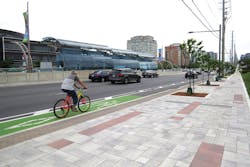No. 2 - vivaNext Highway 7 East Rapidway
Couched in the heart of the greater Toronto area lies York Region, a 678-sq-mile stretch that is home to some 1.1 million souls.
There since 2005 the York Region Rapid Transit Corp. (YRRTC) has been engaged in the multi-phase vivaNext Rapid Transit Network project, one significant portion of which stands at No. 2 on the 2015 Roads & Bridges Top 10 Roads list.
A multimodal complete street throughway, the $287 million (CAN) Highway East 7 Rapidway segment now boasts 10 bus rapid transit (BRT) stations at key intersections, nine of which are center-lane. The stations are comprised of steel half-arch frames supporting blue-glass panels cantilevered over waiting areas and passenger platforms. In an effort to create an iconic look that also bore an historic air, designers borrowed from European examples, notably with the 88.6-ft-long glass canopies, which include heated enclosures.
The BRT line features transit-signal priority, facilitated by radio and infrared receivers along with loop detectors in the roadway itself that can detect both cars and bicycles waiting at intersections. Variable message signs at each platform offer scheduling and arrival information, sourced from on-board GPS.
The physical makeup of the BRT lanes was a particular point of concern for designers, according to Liza Sheppard, Senior Project Manager, who told Roads & Bridges that the Transportation Association of Canada designated red as the color for all BRT lanes. “The design of the red asphalt provided an opportunity to construct a mix that was durable considering [both] traffic movements and Ontario’s variable climate,” said Sheppard.
The final “look” of the mix was achieved via the inclusion of red aggregates introduced into polymer-modified black asphalt cement (PG 70-28), along with the addition of a specially engineered red pigment. In an effort to supply sustainable infrastructure, 4.6-ft-wide bike lanes were installed with a 1.6-ft buffer zone between bike and vehicle traffic. These lanes were discriminated from ordinary traffic lanes by a high-contrast green paint. Moreover, curb-inset bike boxes were installed at intersections to trigger traffic signals via in-pavement detection loops, allowing bicyclists to turn left without crossing traffic in the left-turn lane.
Wider sidewalks were laid down and traffic speed limits were reduced from 50 mph to 37 mph. Landscaping along the outer edges of the sidewalks also provides a buffer between pedestrians and vehicle traffic.
Results were realized with relative speed, once the corridor opened: a 35% reduction in BRT travel times and a 10% increase in ridership. Moreover, bike traffic increased more than tenfold. R&B
Location: Highway 7 East, town of Richmond and city of Markham, Ontario, Canada
Owner: The Regional Municipality of York
Designers: Delcan; AECOM; IBI Group
Contractor: Kiewit EllisDon (KED), a partnership
Cost: $287 million (CAN)
Length: 3.73 miles
Completion Date: Sept. 9, 2014
